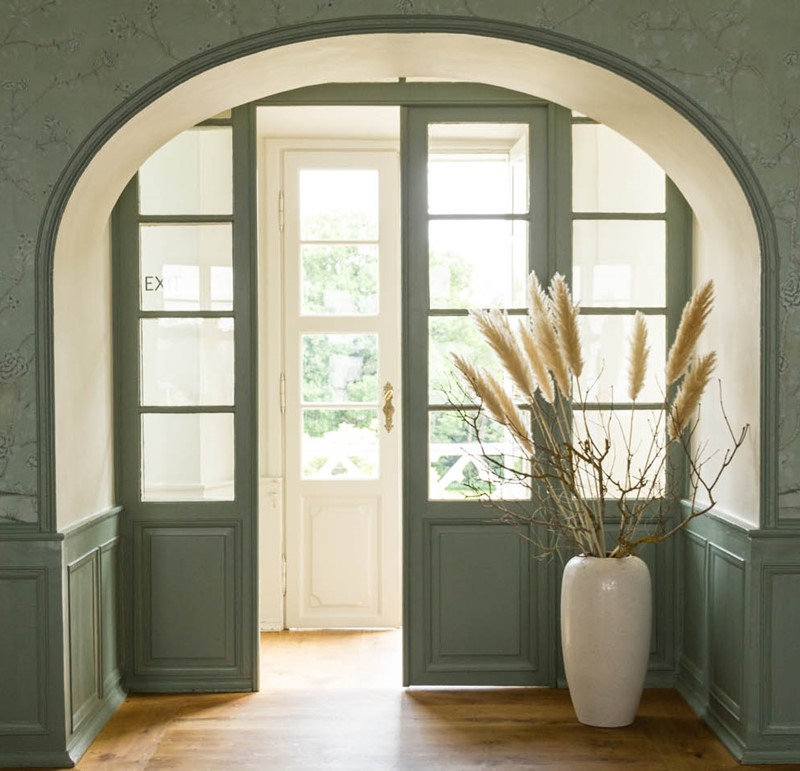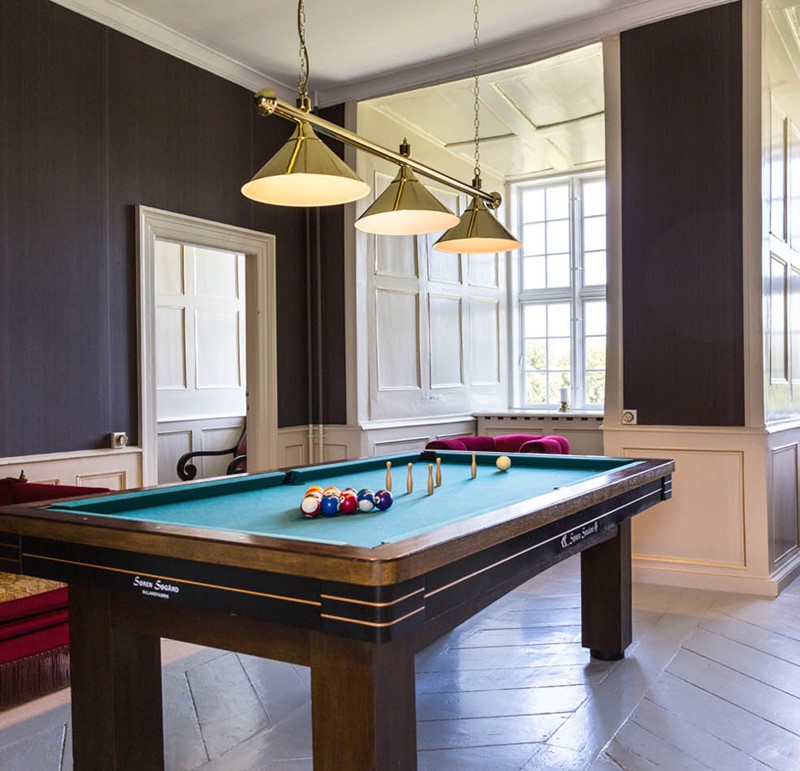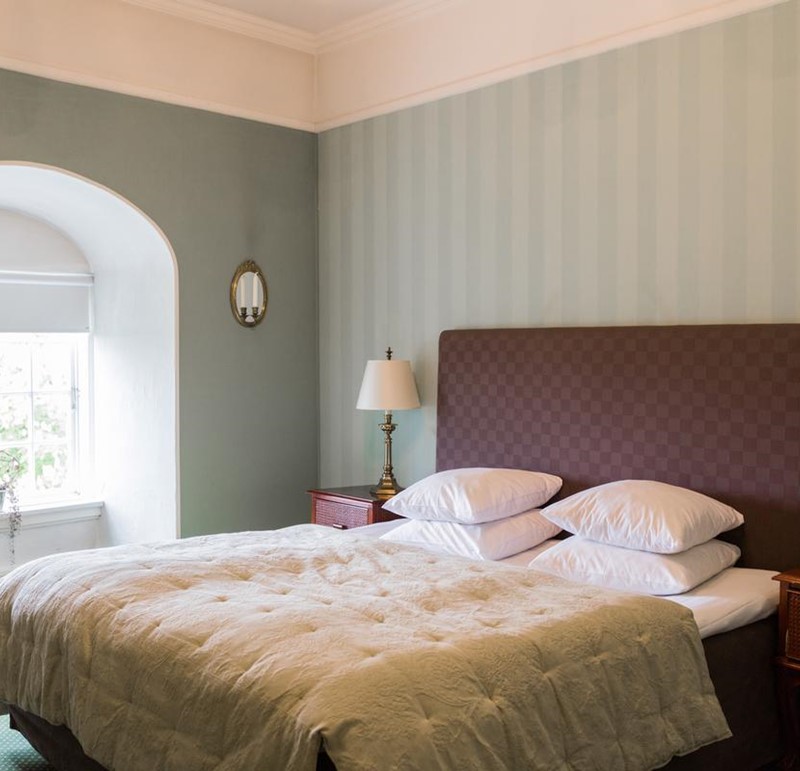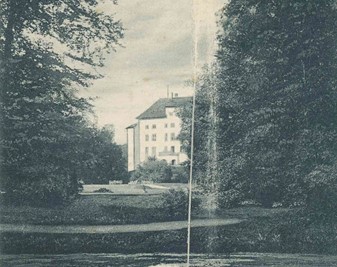
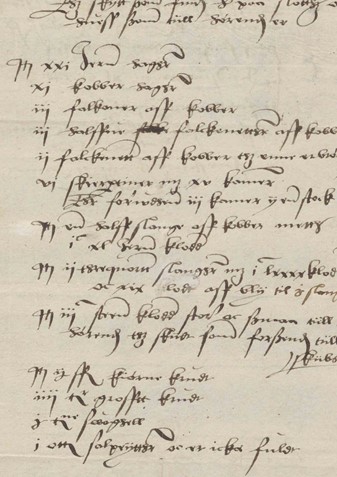
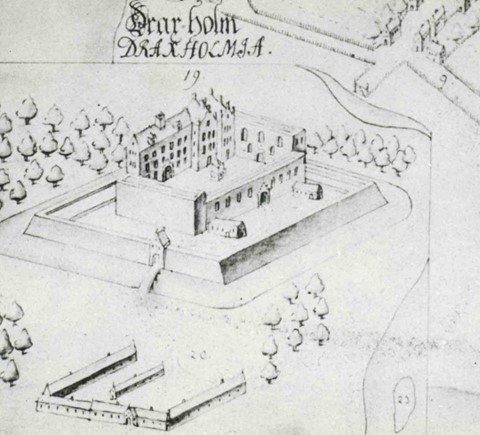
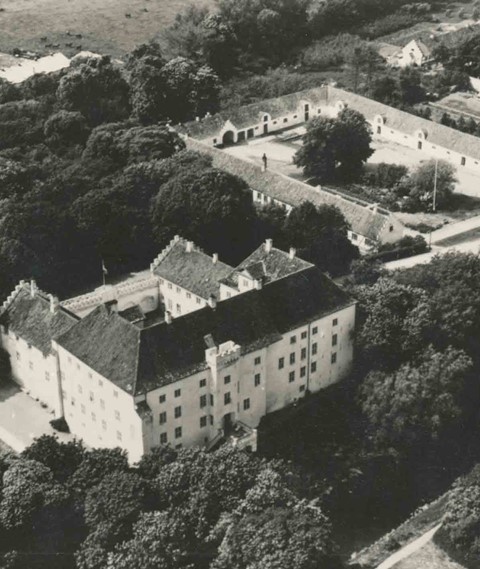
With its long history, Dragsholm Slot offers a rich legacy.
The castle in scenic Odsherred is one of Denmark’s oldest, dating back more than 800 years. Over the centuries, wars have raged, the Castle Chapel has been the setting for aristocratic weddings, and prominent prisoners have been led across the castle courtyard. Today, Dragsholm Slot serves as a hotel with 41 double rooms, several renowned restaurants, and facilities for private events, meetings and conferences as well as a chapel for weddings and religious services.
We are dedicated to offering our guests total immersive experiences. Our aim is to preserve and pass on the authenticity, heritage and character of the area, while at the same time connecting the castle and its cultural heritage with the aesthetics and modern comforts of the 21st century.
THE ORIGINAL DRAGSHOLM
The original Dragsholm was not a castle but referred to as a palace. There are no known sources to help with reliable dating, but certain clues can with reasonable certainty indicate when the oldest Dragsholm was built. The Bishop of Roskilde, Peder Sunesen (bishop 1191-1214) had triple-jointed Romanesque windows installed in the then newly constructed ambulatory of Roskilde Cathedral. The very same type of window was used at Dragsholm, which is evident from the bricked-up window seen at the eastern end of the south wall. The windows at Dragsholm measured 4.6 and 3.6 metres in height respectively and were grouped in sets of three, so that a tall window was flanked on either side by two slightly lower ones. Such window sections were not common in Denmark at the time, which is why it must be assumed that the owner and the master builder of Dragsholm Slot were the same people who also constructed the apse at Roskilde Cathedral. A conservative estimate for the dating of the first Dragsholm Slot could be 1215. The building initially consisted of a main wing to the south with a gabled hall that was 22.5 metres long and 6 metres tall. Below on the ground floor, there were living quarters, a kitchen, etc. On sunny days, markings can still be seen in the south castle wall of the three triple-hung Romanesque windows (nine in total) next to the two lower rows of the current four-sectioned windows. An eastern side wing was constructed adjacent to the main wing.
DRAGSHOLM IN THE MIDDLE AGES AND RENAISSANCE
During the first centuries of Dragsholm’s history, the original palatial building was expanded and rebuilt to become a four-winged fortress castle. The previously mentioned windows were bricked up and replaced by smaller ones, the walls were made thicker to the south, with masonry added from the inside. The whole castle islet was constructed with fortifications of different nature, and the moat was made deeper and wider. In the north-eastern corner, a castle tower was erected atop the existing walls. The tower measured 32 metres in height, was 10 by 10 metres at the base, and had approx. 2-metre-thick walls. Thus, the original palace was gradually transformed into a fortified castle.
THE COUNT’S FEUD AND THE REFORMATION
The transition from the Middle Ages to the Renaissance was marked in Denmark by the Reformation in 1536. The Reformation came about as a result of a war of succession (or feud), known as the Count’s Feud, which lasted for approximately two years. The war was won by Duke Christian (crowned as Christian III) over the Lübeck army under the leadership of Count Christoffer of Oldenburg, from whom the feud takes its name. Dragsholm was besieged from January 1535 for approximately four months. During this siege, it was fired upon by Count Johan of Hoya (Hoyer) from the losing party of the war. However, Dragsholm was never subjected to assault, which is why the castle when the war was over remained under the control of the Bishop of Roskilde, Joachim Rønnow, who was imprisoned along with all other bishops in the nation.
FROM BISHOP’S SEAT TO ROYAL CASTLE
The bishops had initially not wished to support Duke Christian, a Protestant, so by imprisoning the bishops and reforming the church, Christian III strengthened his regal powers. With the bishops’ confiscated property, he could also pay for the two-year war. After threatening the acting seigneur at Dragsholm, the drawbridge was opened for Christian III’s men who thus assumed possession of Dragsholm for the crown. Dragsholm became Dragsholm Slot from where a royal fief was governed.
ROYAL FIEF AND STATE PRISON
It was a rather dilapidated Dragsholm Slot that the king assumed for the crown. The castle remained slightly battered for some years during which only necessary repairs were carried out. Only when Claus Daae (seigneur of Dragsholm from 1624-41) assumed control were major repairs made to Dragsholm Slot. Under the direction of architect Hans van Steenwinckel the Younger, a bay window tower was erected in the restored and now narrower east wing. Not long after, Dragsholm Slot needed another loving hand. As a crown estate during the period from 1536 to 1664, Dragsholm Slot also served as a prison primarily for nobility and clerics. In the large tower in the north-east corner of the medieval castle, secure prison cells were constructed and fitted with “secrets” (toilets) and windows – amenities that would depend on the severity of the prisoner’s crimes, behaviour and perhaps not least the level of insult they had caused the majesty. Famous prisoners at Dragsholm Slot include Roskilde’s last Catholic bishop, the former Lord of the Castle, Joachim Rønnow, the Scottish Earl James Hepburn and landowner Ejler Brockenhuus, who was by all accounts a raving madman.
THE DANO-SWEDISH WAR
In 1657, the Dano-Swedish War (First Karl Gustav War) broke out. The Swedes were busy waging war against Poland, or so the Danish king and the Royal Council mistakenly thought. The Swedish army conquered all of Denmark, taking everyone by surprise. The subsequent peace treaty allowed the Swedish army to stay on Zealand for a few months. During their stay, the Swedes ate their fill at the expense of the Danes and at the same time grew an appetite for a weakened kingdom. The Swedes therefore began yet another occupation of Denmark. Only Copenhagen held out. The Swedes also conquered Dragsholm Slot during the occupation, but apparently, the stronghold had suffered so much damage during the war that the Swedes set up camp at the associated Rødegaard in Vindekilde. However, when peace was reached around 1660, the Swedes decided to blow what was left of the castle sky-high. Gunpowder charges in the tower turned the entire upper section into rubble and caused the east-facing side of the tower to collapse. The impact of the explosion can today still be seen through a hole in the inner wall of the King’s Staircase. Through the hole, you can see sections of the masonry from the 15th century and the shell wall that was constructed during the restoration of the castle in the late 17th century. A source from 1662 states about Dragsholm Slot: "The castle is quite exploded and broken down, so that nothing remains but a few bare walls and stones."
ABSOLUTE MONARCHY AND THE MERCHANT'S CASTLE
After the Dano-Swedish Wars, the Danish crown was on the verge of bankruptcy. The aristocracy, who along with the monarch had monopolised landownership, was also financially strapped following the two-year Swedish siege, which had taken a toll on farmers, farmsteads, manors and the supplies of the seigneurs. Copenhagen merchants together with the king took advantage of the situation to weaken the powers of the aristocracy and instead introduce absolute monarchy in Denmark. Although the king had now gained great powers, he still owed large sums to several Copenhagen merchants for loans to pay the mercenaries who had served the crown during the last war. Merchant Henrik Müller was one of the crown’s biggest lenders. In 1664, Müller assumed ownership of Dragsholm Slot as payment, but since the value of the property was low, he was unable to pay his own debts. He therefore mortgaged Dragsholm Slot to his creditor, the great Portuguese merchant Manuel Teixeira of Hamburg. The latter, however, assumed ownership of Dragsholm Slot for an even worse price than Müller and in 1694 therefore chose to sell the castle to nobleman Frederik Christian Adeler, this time at a price slightly below the value of the farmlands.
ADELER, ADELERSBORG AND DRAGSHOLM SLOT
Frederik Christian Adeler and Henriette Margrethe von Lente marked the completion of the rebuilding and remodelling of Dragsholm Slot in 1697 with wall anchors shaped in their initials combined with the year of completion. These anchors are placed at the upper section of the interior masonry of the east wing. During reconstruction, Adeler strove to recreate the castle in the Baroque style of the times. The Baroque features are the whitewashed walls, the hipped roofs and the ambition to create symmetry in the interior of the castle courtyard, resulting in inappropriate window placements, faux windows and doors. The entrance area in the north-eastern corner demonstrates that during rebuilding, the fortifications of the former stronghold had to be carefully considered, such as erecting in the old tower what is today known the King’s Staircase. Under the Adeler family, Dragsholm was elevated to a barony in 1784, and in 1785 the castle changed its name to Adelersborg. After serving as a family estate (allodial property which could be inherited by daughters) for a number of years, Adelersborg once again became a barony in 1843 under Baron Georg Frederik Otto Zytphen-Adeler, who in 1868 reinstated the name Dragsholm Slot. Baron Zytphen-Adeler was an enterprising man and was, among other things, the initiator of the damming of Lammefjorden between 1873-1943, a land reclamation project.
DRAGSHOLM SLOT IN THE TWENTIETH CENTURY
At the beginning of the 20th century, Dragsholm’s land assets had been heavily diminished, and with the death of the childless baron Frederik Georg de Falsen Zytphen-Adeler in 1932, the State Land Law Committee assumed ownership of Dragsholm Slot. With the abolishment of fiefs (Len) in 1919, Dragsholm Slot passed from barony to freehold. After a major auction of the estate and subdivision of the farmlands, Dragsholm Slot was sold in 1937 to Johan Frederik Bøttger, who leased the castle itself to a third party as a hotel business, while he himself cultivated the remaining estate farmland. With the exception of the WWII Occupation, when German forces set up regional headquarters in Dragsholm Slot, the castle has since 1937 been used as a hotel business.
In 2002, heiress Inge Merete Bøttger became the sole owner of Dragsholm Slot after having settled payment for the deeds with the second heir, her brother Flemming Frederik Bøttger. Since then, Dragsholm Slot has undergone several refurbishments, including raising the standard of the hotel rooms. In August 2005, Inge Merete’s son, Mads Hylleholt Bøttger, was employed as the Director of the castle. In recent years, a number of hotel rooms have been added in the castle’s associated buildings (i.e. in the estate and porter’s residence), just as the restaurant in the castle cellar has been renovated and expanded. With the inauguration in June 2006, the cellar section now includes the castle’s second kitchen, gourmet restaurant and reception. Since the inauguration, the culinary team at the kitchen has worked diligently to include historical references to Lammefjorden and Odsherred in their cuisine. In 2008-2009, the park and moat were restored with funding from the A.P. Møller and Chastine Mc-Kinney Møller Foundation. Additionally, the regional development fund, Udvikling Nordvestsjælland, has provided funding for the redevelopment and expansion of the castle herb garden, which is located where there once was a Baroque ornamental garden. Dragsholm Estate covers 187 hectares.
OWNERS OF DRAGSHOLM SLOT THROUGH THE YEARS
(1313-1536) Roskilde Bishop’s Court
(1536-1664) The Danish Crown
(1664-1682) Henrik Müller
(1688-1694) Manual Texeira
(1694-1727) Frederik Christian von Adeler
(1727-1757) Christian von Lente of Adeler (son)
(1757-1785) Conrad Wilhelm Adeler (nephew)
(1785-1816) Frederik Adeler (son)
(1816-1836) Bertha Moltke married Adeler
(1836-1878) Georg Frederik Otto Zytphen-Adeler (daughter’s daughter’s spouse)
(1878-1908) Frederik Herman Christian de Falsen Zytphen-Adeler (son)
(1908-1932) Georg Frederik de Falsen Zytphen-Adeler (son)
(1932-1936) The Zytphen-Adeler Family
(1936) The Danish National Committee on Ground Law
(1936-1985) Johan Frederik Bøttger
(1985-2002) Flemming Frederik Bøttger / Inge Merete Bøttger
(2002-2015) Inge Merete Bøttger
(2015-) Mads Hylleholt Bøttger
